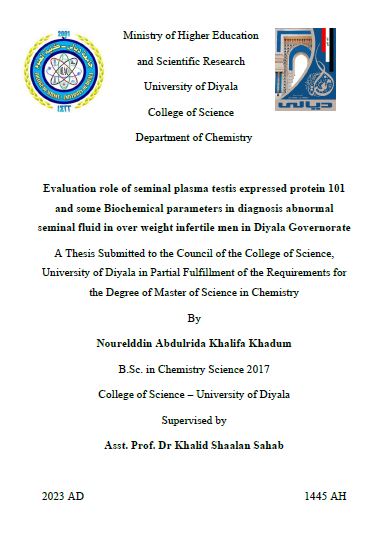المستخلص
Infertility is the inability to conceive, and it is considered one of the complex health problems that affect the male or female reproductive system in either of the spouses or one of them. It can be caused by many disorders such as dysfunction in the reproductive system, a defect in the secretion of some glands, or genetic factors, also can be affected by some factors, including environmental and nutritional factors, injuries in the genital area, or advancing age.
The current study, which was conducted in Diyala Governorate in one of the infertility and in vitro fertilization (IVF) clinics, aims to reveal the relationship of TEX 101 protein and Cholesterol in the seminal plasma to fertility and some serum hormones (follicle-stimulating hormone, luteinizing hormone, prolactin, and testosterone) by classifying infertility cases into three groups, depending on sperm count and motility (according to the World Health Organization).
The study included (132) samples for each group (33) samples, which are each of Asthenozoospermia with an average age (31.57 ± 1.11) and Oligozoospermia (31.09 ± 1.14) with an average age and Azoospermia with an average age (32.09) ± 1.30), while (33) samples taking of healthy subjects (Normozoospermia) as control group, with an average age of (30.93 ± 1.04), where the semen samples were collected after a break period ranging from (3-7) days from the last sexual relationship.
This study revealed a non-significant increase (p>0.05) in the pH values in the Oligozoospermia group compared to Asthenozoospermia, Azoospermia and Normozoospermia groups, and a significant decrease (p<0.05) in the count of sperm and a non-significant decrease (p>0.05) in the volume of semen in the Asthenozoospermia, Oligozoospermia, Azoospermia groups compared to the Normozoospermia ones, and a significant increase (p<0.05) in the proportion of progressive motility of sperms and a significant decrease (p<0.05) in the proportion of non-progressive motility of sperms and the proportion of immotile sperms in Normozoospermia group compared to the Asthenozoospermia, Oligozoospermia, Azoospermia groups.
and a significant increase (p<0.05) in the percentage of normal sperm shape and a significant decrease (p<0.05) in the percentage of abnormal sperm shape in Normozoospermia group compared to the Asthenozoospermia, Oligozoospermia, Azoospermia groups.
As for the level of testis expressed protein 101, a non-significant increase (p>0.05) was observed in the Oligozoospermia group compared to Asthenozoospermia, Azoospermia and Normozoospermia groups, and a significant decrease (p<0.05) was observed in the level of cholesterol in each of the Asthenozoospermia and Oligozoospermia groups compared to the Normozoospermia and Azoospermia groups.
A significant increase (p<0.05) in the level of Follicle-stimulating hormone and luteinizing hormone was observed in the Azoospermia group compared to Normozoospermia, Asthenozoospermia and Oligozoospermia groups, and a non-significant decrease (p>0.05) in the testosterone level in the Azoospermia group compared to Asthenozoospermia, Oligozoospermia and Normozoospermia groups, and a non-significant increase (p>0.05) in the prolactin hormone level in the Azoospermia group sperm compared to Asthenozoospermia, Oligozoospermia and Normozoospermia groups.
We conclude from this study that any imbalance in the level of semen parameters can lead to infertility, and that an imbalance in hormone levels can lead to problems in the number, motility, morphology of sperm, and semen volume, and there is no effect observed in the level of TEX 101 protein on semen parameters. Low Cholesterol in seminal plasma can correlated to infertility of the type of Asthenozoospermia and Oligozoospermia and that increased level of cholesterol in seminal plasma can correlated to infertility of the type of Azoospermia.





